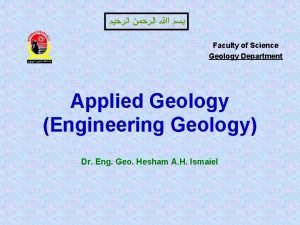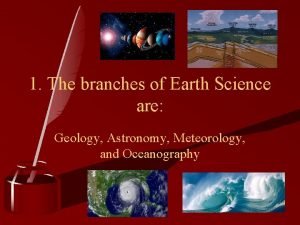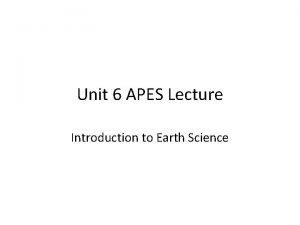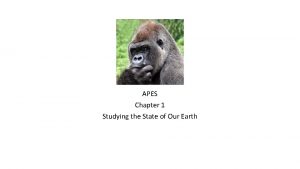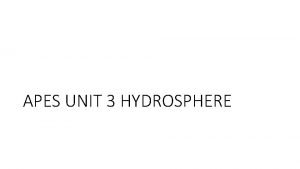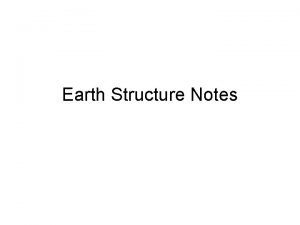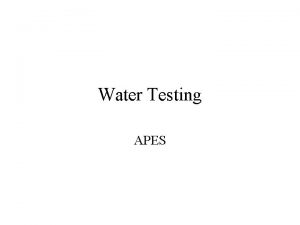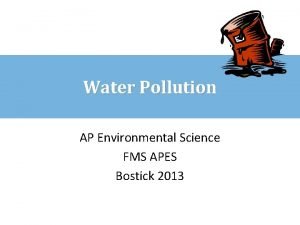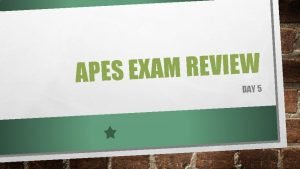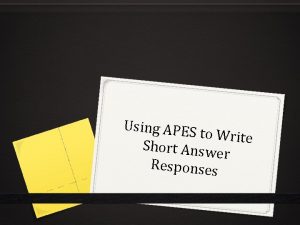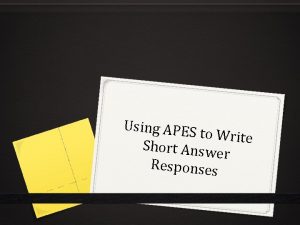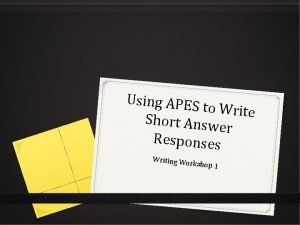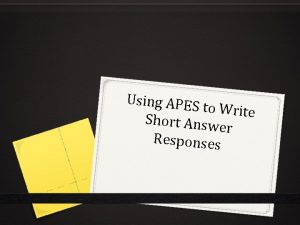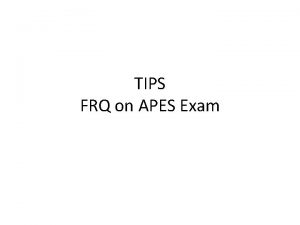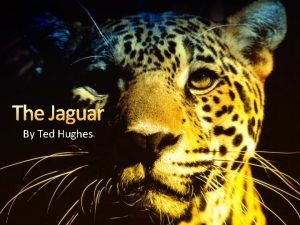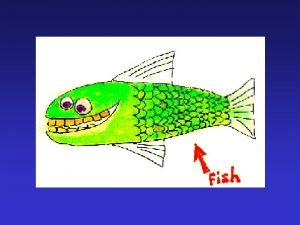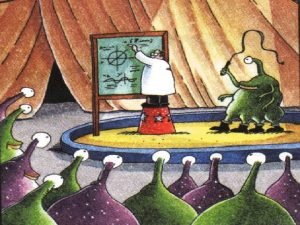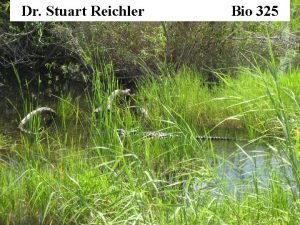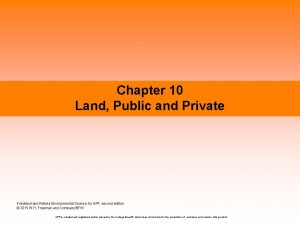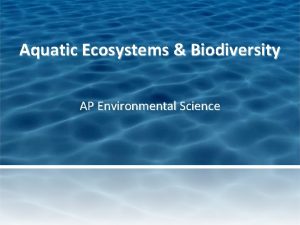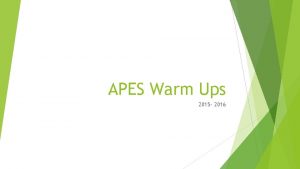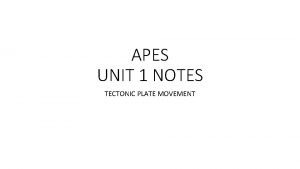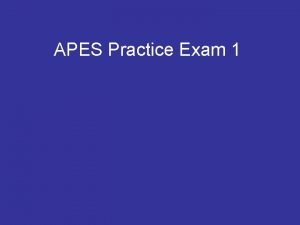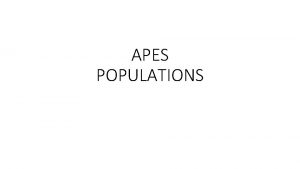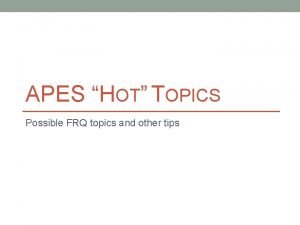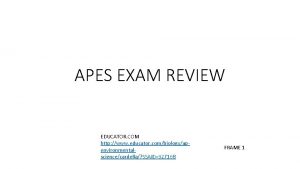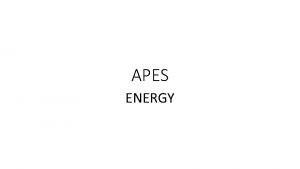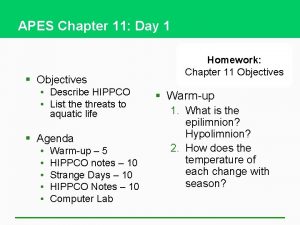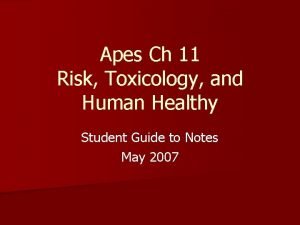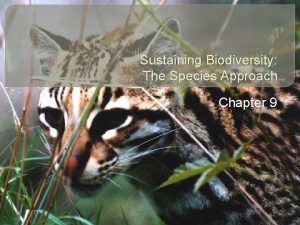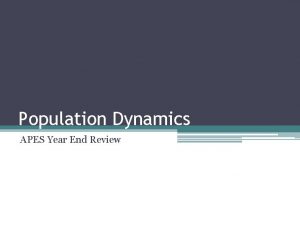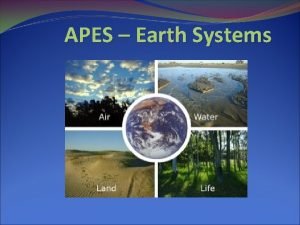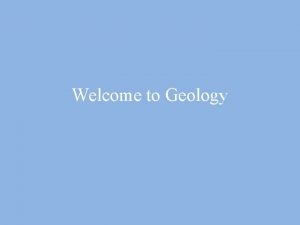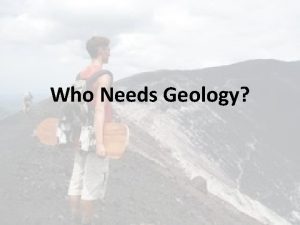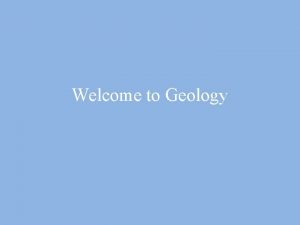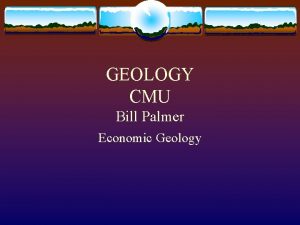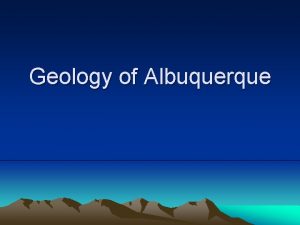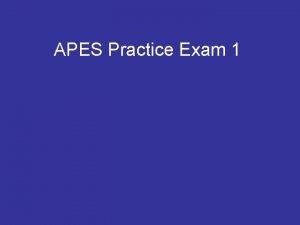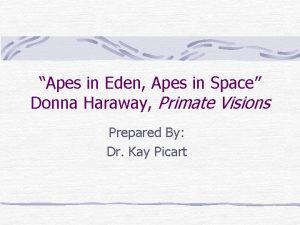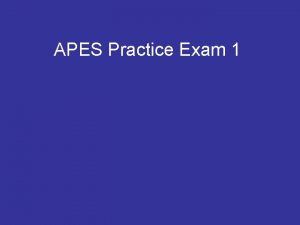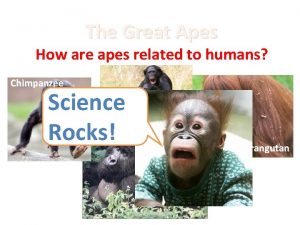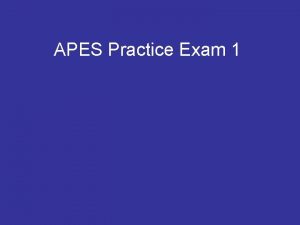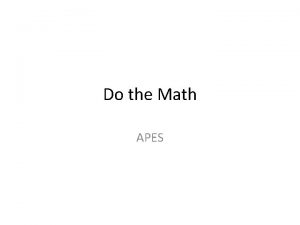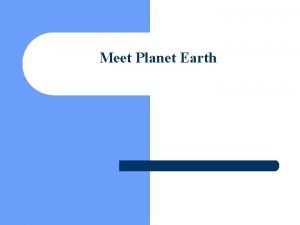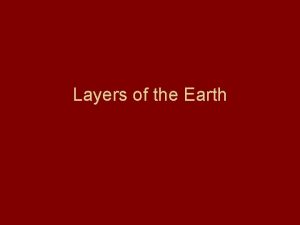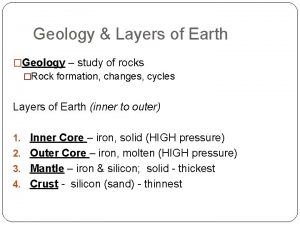APES UNIT 1 NOTES EARTH SYSTEMS GEOLOGY HOW








































- Slides: 40

APES UNIT 1 NOTES EARTH SYSTEMS (GEOLOGY)

HOW EARTH FORMED - CAME FROM COSMIC DUST IN THE SOLAR SYSTEM (BIG BANG THEORY) ALL THE ELEMENTS FOUND ON EARTH ARE AS OLD AS EARTH EARLY EARTH WAS A HOT, MOLTEN SPHERE AS MOLTEN MATERIAL COOLED, THE ELEMENTS SEPARATED INTO LAYERS BASED ON MASS (HEAVY IRON TOWARDS THE CENTER) https: //www. youtube. com/watc h? v=BBwqend. K 8 zc

JAMES HUTTON “FATHER OF MODERN GEOLOGY” Figured out sedimentary rock gets compacted and compressed over time PRINCIPLE OF UNIFORMITARIANISM= changes in the Earth’s surface happened slowly. Example: gradual shifting across different continental land forms https: //www. youtube. com/watch? v=l. Mf. PSdrrj. ZI

RELATIVE TIME MEASUREMENTS Measurements that give you the age of rock and soil layers by comparing them to layers above and below RELATIVE DATING PRINCIPLE OF SUPERPOSITION Dates an unknown sample to a certain time period when compared to samples of a known time period Top layers are youngest Bottom layers are oldest Strata are laid down in succession (layers are piled on top of each other over time)

ABSOLUTE DATING Process of determining an approximate age of rocks by using radiometric methods https: //www. youtube. com/watch? v=ph. Ze. E 7 Att_s

EARTH LAYERS BECAUSE EARTH’S ELEMENTS SETTLED INTO PLACE BASED ON MASS…… EARTH IS DIVIDED INTO LAYERS 2 GROUPS OF LAYERS: COMPOSITIONAL LAYERS & PHYSICAL LAYERS KNOWLEDGE OF EARTH’S LAYERS *SEISMIC WAVES ANALYSIS *LAVA ANALYSIS *METERITE COMPOSITION

COMPOSITIONAL LAYERS OF EARTH CRUST = thinnest, outermost layer, solid , brittle, coolest layer, mostly oxygen MANTLE = medium density, has magma that circulates, mostly iron, magnesium, aluminum CORE = innermost layer, greatest density, hottest, mostly iron and nickel

PHYSICAL LAYERS OF EARTH 1. LITHOSPHERE = outer layer, includes crust and uppermost mantle, divided into tectonic plates 2. ASTHENOSPHERE = middle part of mantle, flexible, rock flows slowly 3. MESOPHERE = lower part of mantle 4. OUTER CORE = outer part of core, dense liquid nickel and iron 5. INNER CORE = inner most part of core, dense solid nickel and iron due to pressure, over 4000 ° C

Comparison of the Compositional and Physical Layers

CONTINENTAL DRIFT THEORY ALFRED WEGENER proposed all continents originally formed from one landmass (PANGEA) EVIDENCE OF CONTINENTAL DRIFT: 1. Fossilized tropical plants in Greenland 2. Glacial landscapes in the tropics 3. Tropical regions show past polar climates 4. Continents fit together like puzzle pieces 5. Rock similarities in east coast of one continent and west coast of another

PLATE TECTONICS THEORY States that the Earth’s lithosphere is divided into plates that are in constant motion. It describes the formation and movement of the oceanic and continental plates. Plate Tectonics explains biological evolution, formation of mountains, volcanoes, earthquakes and volcanic eruptions. *some plates move 1 cm/yr

TECTONIC PLATES are large pieces of lithosphere that float on the asthenosphere. *There about 15 Tectonic Plates that drift slowly over the mantle *Oceanic plates are topped with *Oceanic plates are thinner and denser oceanic crust (mostly iron) *Continental plates are topped with *Continental plates are thicker and less dense (mostly silicon dioxide) continental crust

WHY DO PLATES MOVE? https: //www. youtube. com/watch? v=kwf. NGatx. UJI CONVECTION: is the process of heat transfer within the Earth that causes hot, less dense matter to rise and cool matter to sink which circulates material and forms Convection Currents. Mantle Convection occurs because of thermal gradient between core and crust. ****Convection drives plates together and apart. The heat transfer provides the power.

PLATE BOUNDARIES Plate Boundaries are the edges/margins of the plates. There are 3 types of Plate Boundary Interactions: 1. DIVERGENT BOUNDARY 2. CONVERGENT BOUNDARY 3. TRANSPORM FAULT BOUNDARY

DIVERGENT BOUNDARY *Where 2 plate move away from each other. *Causes a gap that can be filled with magma forming new lithosphere (This is called Sea Floor Spreading) *Forms Ridges and Rift Valleys

2 KINDS OF DIVERGENT BOUNDARIES 1. OCEANIC DIVERGENT BOUNDARY EXAMPLE: MID-ATLANTIC RIDGE 2. CONTINENTAL DIVERGENT BOUNDARY EXAMPLE: EAST AFRICAN RIFT VALLEY

CONVERGENT BOUNDARY When 2 plates move towards each other. One plate will be pushed below the other forming trenches in the ocean and mountain range in the continents. *SUBDUCTION= heavy plate is pushed under the lighter plate *SUBDUCTION ZONES= is where subduction takes place *The Subducting plate will melt in the Asthenosphere 3 kinds of Convergent Boundaries: 1. Oceanic-Oceanic convergence 2. Oceanic-Continental convergence 3. Continental-Continental convergence

OCEANIC-OCEANIC CONVERGENCE *creates trenches and Island Arcs HOT SPOT Hotspot = a narrow stream of hot mantle convecting up from the mantle-core boundary called a mantle plume *creates an Island arc Example: Japan

OCEANIC-CONTINENTAL CONVERGENCE *The denser oceanic plate will move underneath less dense continental plate (subduction). *Forms trenches, Volcanoes , Volcanic arc, Mountain ranges. EXAMPLE: ANDES MOUNTAIN RANGE IN SOUTH AMERICA

CONTINENTAL-CONTINENTAL CONVERGENCE • Mountain Ranges are created because of compression and uplifting. • EXAMPLE: The Himalayas in Asia

TRANSFORM FAULT BOUNDARY • When two plates slide from side to side, parallel • A fault (fracture) forms between plates • The friction and stress building causes Earthquakes • EXAMPLE: San Andreas Fault in California

COMPARING PLATE BOUNDARIES

REVIEW BOUNDARIES RIDGE


EARTHQUAKES http: //www. iknowthat. com/mhscience/ Earthquakes/Fixed. htm *OCCUR ALONG TRANSFORM PLATE BOUNDARIES *pressure builds up from the sliding friction and is released abruptly *the pressure released causes Seismic waves *FOCUS= the area where the energy starts and is released *EPICENTER= the area on the surface directly above the focus https: //www. youtube. com/watch? v=0 Crx. E Rh. QWK 4

SEISMIC WAVES Seismic waves travel outward from the focus in all directions. There are 2 classes of Seismic Waves: 1. BODY WAVES 2. SURFACE WAVES=travel along Earth’s surface , slower than Body waves (consist of Love waves and Rayleigh waves) BODY WAVES= travel through interior Earth *P waves through bedrock and are the fastest waves (the denser-the faster), travel parallel to direction of transmission. *S waves through uppermost layers of Earth. They travel slower (60%) and perpendicular

RICHTER SCALE *The magnitude (strength/energy) of an Earthquake is measured in logarithmic Richter Scale by a Seismograph onto a Seismogram. *The Richter Scale is really comparing amplitudes of waves *Each unit whole number represents an amplitude 10 X greater than the next smaller unit. (EX. 5. 0 is 10 X greater than 4. 0 ) (EX. 6. 0 is 100 X greater than 4. 0)

PRIMARY EFFECTS shaking ground damage to buildings permanent displacement damage to life SECONDARY EFFECTS rockslides flooding sinkholes fires tsunamis

TSUNAMIS VERY LARGE OCEANIC WAVES OR CAUSED THE MOVEMENT OF THE EARTH DURING AN EARTHQUAKE.

VOLCANOES *Eruptions occur when pressure within a magma chamber forces molten magma up through a conduit (pipe) and out a vent at the top of the volcano. *The type of eruption depends on the gases, the amount of silica in the magma (which determines viscosity), and how free the conduit is (whether the volcano flows or explodes). *Correlation exists between seismic and volcanic activity. *Benefits of volcanic eruptions include producing new landforms (Hawaiian Islands) and increased soil nutrient levels produced from erosion of lava rock.

Active volcanoes produce magma (melted rock) at the surface. Other types of volcanoes are classified as intermittent, dormant (have not erupted within recorded history), or extinct (will never erupt again). The majority of volcanoes – 95%- occur at subduction zones (where plates collide and move past one another) and mid-oceanic ridges (where plates move away from each other). The remaining 5% occur at hot spots, areas where plumes of magma come close to the surface.

HOT SPOT VOLCANOES – HAWAIIN ISLANDS As plate moves over a hot spot, heat from rising plume melts crust and forms another volcano

Volcanic Ash *Volcanoes may produce ejecta (lava rock and/or ash), molten lava, and/or toxic gases. *Common gases released include: steam, carbon dioxide, sulfur dioxide, and hydrogen chloride. *Volcanoes can affect climate by introducing large quantities of sulfur dioxide (SO 2) into the atmosphere that is later converted into sulfate ions (SO 4) in the stratosphere. The sulfate particles reflect shorter wavelengths of solar radiation and serve as condensation nuclei for high clouds. *In 1992, the year after Mt. Pinatubo erupted, the effect of stratospheric sulfate particles decreased average global temperatures by as much as 1 F by decreasing the amount of sunlight that reached the earth. *The particles settle out of the atmosphere usually within two years and contribute to acid rain.

VOLCANOES *magma chamber forces molten magma up through Conduit (pipe) *ACTIVE VOLCANOES = currently erupted in the past 10, 000 years *DORMANT VOLCANOES = have never erupted in recorded history *EXTINCT VOLCANOES = will never erupt again (does not have molten lava) *Volcanoes produce ejecta (chunks of lava rock), molten liquid lava, toxic gases, volcanic ash, *EXAMPLE: (1980) MT. Saint Helens (Washington state) removed trees, increase soil erosion, destroyed wildlife, polluted air, flooding from clogged rivers, 57 people died

4 major types. Vary based upon size shape, and how they are formed.

Shield Are very large and are built by many layers of runny lava flows. As the very fluid lava spills out of a central vent or group of vents, a broad-shaped, gently sloping cone is formed. Shield volcanoes may be produced by hot spots that lie away from the edges of tectonic plates. Shield volcanoes also occur along mid-oceanic ridges, where seafloor spreading is in progress, and along subduction-related volcanic arcs. Examples: Mauna Loa and Kilauea in Hawaii.

Cinder Cones Steep, conical hill formed above a vent. Among the most common landforms found around the world and do not cause significant loss of life. Cones usually grow up in groups, and they often occur on the flanks of composite and shield volcanoes. Built from lava fragments called cinders. The lava fragments are ejected from a single vent and accumulate around the vent when they fall back to earth. Grow rapidly and soon approach their maximum size. Rarely exceed 800 feet (250 m) in height and 1, 600 feet (500 m) in diameters. Example: Paricutin in Mexico, which grew to 300 feet (90 m) in 5 days.

Composite (Strato) Formed from alternating layers of lava and rock fragments. Constructed along subduction zones, and often form impressive, snow capped peaks that often exceed 1. 5 miles (2, 500 m) in height. Between eruptions they are often so quite they seem extinct. When a viscous magma rises to the surface it usually clogs the crater pipe. Gases build up pressure and results in an explosive eruption. Examples: Mount Hood, Mount Rainier, Mount Shasta, Mount Pinatubo, Mount Fuji, and Mount Vesuvius Lava domes are a principle structural feature of a composite cone. The large amount of silica in the lava does not allow the lava to flow far from the vent. Lava domes grow slowly and steadily for month or years. When part of the lava dome collapses while it still contains molten rock or gases, it produces a pyroclastic flow – a lethal event.

LAVA DOME In volcanology, a lava dome or volcanic dome is a roughly circular mound-shaped protrusion resulting from the slow extrusion of viscous lava from a volcano. The geochemistry of lava domes can vary from basalt to rhyolite although most preserved domes tend to have high silica content.

REDUCE EARTHQUAKE AND VOLCANO DAMAGE *examine history and calculate probability from data analysis *study precursors such as changes in the cone, changes in temperature, gas composition and seismic activity *map out locations *strengthen building codes and better evacuation plans *educate public
 Geology earth science definition
Geology earth science definition Geology earth science definition
Geology earth science definition Zone of aeration
Zone of aeration Earth science vs geology
Earth science vs geology Unit 6 apes
Unit 6 apes Biomes
Biomes Apes chapter 1 review
Apes chapter 1 review Apes unit 8
Apes unit 8 Unit 10, unit 10 review tests, unit 10 general test
Unit 10, unit 10 review tests, unit 10 general test Lithosphere ppt
Lithosphere ppt Properties of core of the earth
Properties of core of the earth Wisc
Wisc Turbidity apes
Turbidity apes Water pollution paragraph for class 8
Water pollution paragraph for class 8 Tailings definition apes
Tailings definition apes Apes format
Apes format Apes response
Apes response Apes writing
Apes writing Short answer test questions examples
Short answer test questions examples Tragedy of the commons easter island
Tragedy of the commons easter island Apes frq
Apes frq Jaguar ted hughes
Jaguar ted hughes 2013 apes frq
2013 apes frq Positive vs negative feedback loop apes
Positive vs negative feedback loop apes Apes percent change
Apes percent change Apes 325 template
Apes 325 template Urban blight definition apes
Urban blight definition apes Ap environmental science aquatic biomes
Ap environmental science aquatic biomes Apes frq 2016
Apes frq 2016 Plate boundaries apes
Plate boundaries apes E-waste definition apes
E-waste definition apes Apes quiz
Apes quiz Rule of 70 population growth
Rule of 70 population growth Apeshot
Apeshot Apes exam review
Apes exam review Cons of coal
Cons of coal Hippco apes
Hippco apes Apes 2004 frq
Apes 2004 frq Apes cycles
Apes cycles Apes chapter 9 sustaining biodiversity
Apes chapter 9 sustaining biodiversity Rlf apes
Rlf apes
